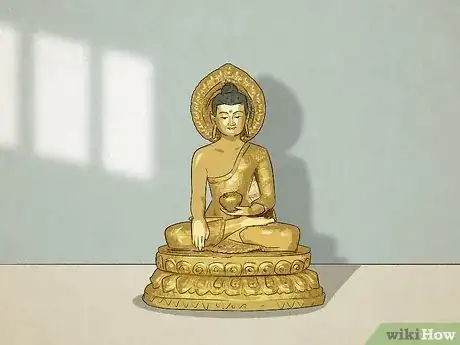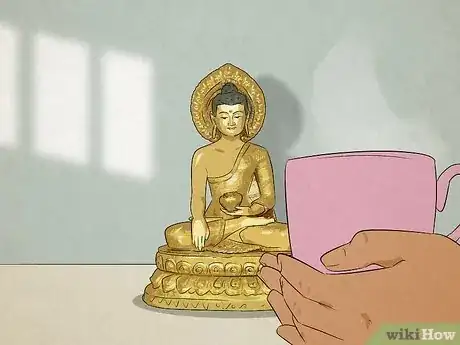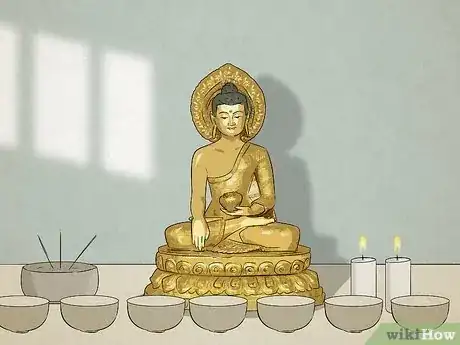X
wikiHow is a “wiki,” similar to Wikipedia, which means that many of our articles are co-written by multiple authors. To create this article, volunteer authors worked to edit and improve it over time.
This article has been viewed 54,415 times.
Learn more...
A proper shrine should hold images or representations of the Buddha's enlightened body, speech and mind which serve as reminders of the goal of Buddhist practice - Enlightenment for the sake of all beings. The reason for setting up a shrine is not for fame, for showing off wealth, or to increase pride, but rather it is to reduce one's mental afflictions.
Steps
-
1Find a place for it. The best place to put the shrine is in a separate room, but if you live in a small house and cannot set aside a separate room, any room will do. The size of the shrine is not important, but it should be in a clean and respectful and higher than the level of your head as you sit facing it. If you put it in your bedroom, it should be placed near the head of your bed, never at the foot, and it should be higher than the bed. The shrine should be placed on a separate table and not be doubled as a coffee table or night-stand.
-
2Place an image of Buddha. The first object that should be placed on the shrine is an image of Shakyamuni Buddha. You can place images of other Buddhas or Bodhisattvas on the shrine as well but Shakyamuni Buddha should be the central figure. These should be on the top level of the shrine.Advertisement
-
3Have a Buddhist scripture. On the next level there should be a Buddhist scripture, representing the speech of the Buddha and there should be a Stupa of Enlightenment (chorten in Tibetan), which represents the mind of the Buddha. You do not have to have a gold stupa, a picture or clay model is perfectly acceptable.
-
4Make Offerings.
- All offerings made should be on the level under the Stupa and the Scripture.
- In the Tibetan Buddhist Tradition it is custom to offer seven bowls of water, which represent the seven limbs of prayer.
- Flowers, candles or butter lamps, and incense are also commonly offered. It is customary to offer a part of every meal on the shrine before eating and a portion of tea before drinking. The things that should be offered should be clean, new and pleasing. . . . only the best part, fresh, and clean -- never old, leftover, or spoiled food.
-
5Place the Offerings on the Shrine.
- To offer water on your shrine, you should have a minimum of seven bowls. Start with fresh water every day. The bowls should be clean. Pour a little water into each bowl before placing it on the shrine. Place the bowls in a straight line, close together but not touching.
- Try not to breathe on the offerings. If you have a butter lamp, you can place it on your shrine between the third and fourth water bowls. Lamps or candles symbolize wisdom, eliminating the darkness of ignorance. In Tibetan monasteries hundreds of lamps are lit as offerings. There is really no limit to the quantity of either water bowls or lamps.
- It is also custom to have eight offerings with the bowls of water. They are as follows:
- Water to Cleanse the Mouth or Face - This Represents Auspiciousness
- Water to Wash the Feet - This Represents Purification (You do not need to add extra water. What is in the seven bowls is enough.)
- Flowers - This Represents Generosity
- Incense - This Represents Discipline, Moral Ethics
- Light - This Represents Patience
- Fragrance - This Represents Perseverance (This can be Sandalwood or Saffron)
- Delicious Food - This Represents Samadhi (Concentration)
- Musical Instruments - Tis Represents Wisdom (You can use guitars, lutes, cymbals, singing bowls, etc.)
- After pouring the water, lighting the candles and offering incense, bless the offerings by dipping a piece of kusha grass (or a tree twig) into the water, reciting three times OM AH HUM, and then sprinkling the offerings with water. Visualize that the offerings are blessed.
- It is excellent to dedicate the merit of making offerings to the elimination of suffering and its causes from all beings, to their achievement of lasting happiness, and to world peace.
- At the end of the day, before or at sunset, empty the bowls one by one, dry them with a clean cloth and stack them upside down or put them away. Never leave empty bowls right side up on the shrine. The water is not simply thrown away but offered to the plants in your house or in the garden.
- Food and flowers should also be put in a clean place outside where birds and animals can eat them. Bowls of fruit can be left on the shrine for a few days and can then be eaten when they come down -- there is no need to put them outside.
Advertisement
Community Q&A
-
QuestionIn what direction should a shambhala shrine be placed?
 Tara TKCommunity AnswerAs far as I know, there is no "correct" way to place it. It depends on your space and mind. You can place it anywhere you find it to be peaceful.
Tara TKCommunity AnswerAs far as I know, there is no "correct" way to place it. It depends on your space and mind. You can place it anywhere you find it to be peaceful.
Advertisement
About This Article
Advertisement








-Step-10-Version-3.webp)








-Step-11.webp)









-Step-10-Version-3.webp)


































